Restaurant menus in kanji
Reading kanji has been one of the tougher experiences for me here. I am able to decipher a few kanji on public transport and for general navigation. I recognize bicycle, 自転車 jitensha, for knowing where we can bike. Any signage with 禁止 means the indicated activity is not allowed (and there are many of these kinds of signs). That being said, there is also a lot of signage in the two other Japanese alphabets, hiragana and katakana, and the English alphabet.
Where low kanji literacy feels precarious is in restaurants. I furiously translate on my app and memorize characters used for common foods. We take a while to order, ordering in little spurts, a couple plates here and there. Sometimes I am fried and trying to translate is too much. So then ordering becomes more random, and as we wait for our food, we vaguely hope that we get something-ish of what we think we got.
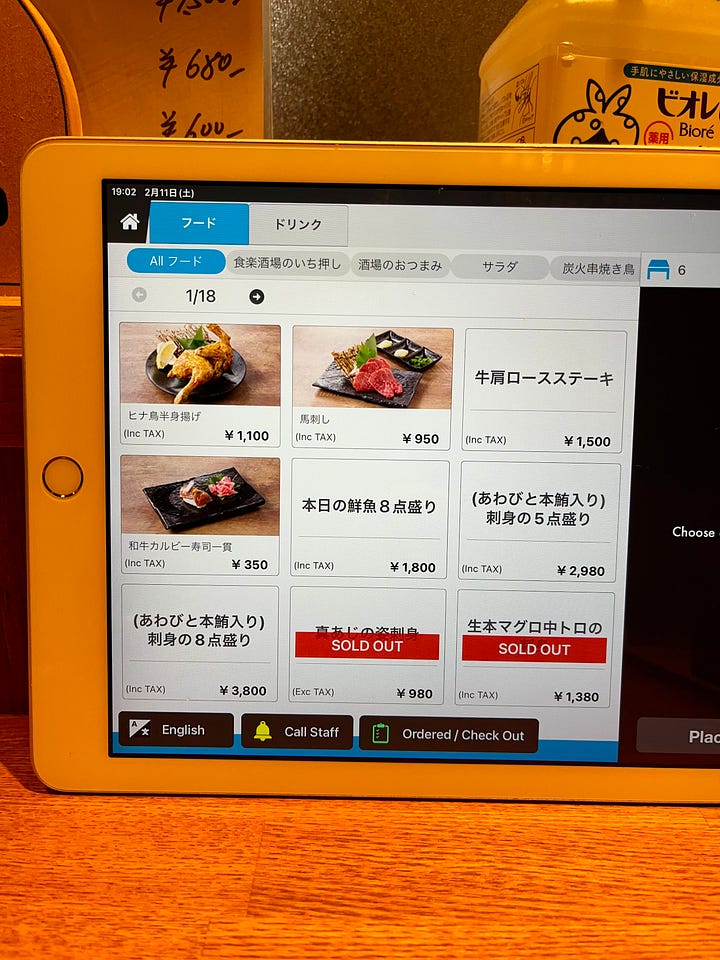
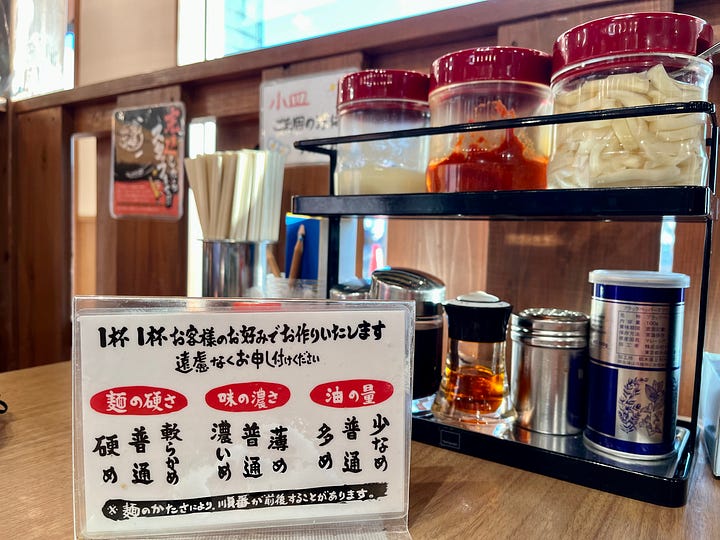
When we go to an izakaya with tablets, it can be a reprieve. There are pictures that nicely match my literacy level of a Japanese four year old. Sometimes these tablets have an English language selection, although this language translation can be hit or miss. We enter orders in our own time. In other kinds of eateries katakana is used. It is the Japanese alphabet for foreign words. As I sound out the katakana, it’s satisfying to recognize the English word that comes through, e.g. パンナコッタ = pannacotta.
No going under the radar
It is hard to hide in a Japanese restaurant. Japan has a very service-oriented culture, so people greet you extensively and often observe you from the corner of their eye in order to be properly attentive for when you need something. There are a number of certain dishes where it can be customary to ask for your specific preferences (that meticulousness again). So you’re suddenly asked quite particular questions that may be difficult to anticipate as a foreigner.
An increasingly favorite word of mine is 普通 futsuu, the first character of which means “universal,” and the two kanji together meaning normal or ordinary. It is used to indicate you want the “normal-cooked” ramen noodles, or the “normal-sized” rice bowl, or the “normal-flavored” broth, and so on. This being said, the other day I tried to use the word futsuu to indicate the ramen bowl size I wanted when I couldn’t read the kanji used for “middle” size. I was then informed, “futsuu ga arimasen” (“there is no normal”). Oh boy.
The three-dimensionality of kanji
Kanji has the potential to offer meaning in a three dimensional way. A character may have many meanings attributed to it. The way that it is then used for many kinds of words can be interesting. It gives a window into how Japanese may perceive an object in a way that is not verbalized, but is literally visible via the kanji.
For example, 空車 blinks on the electronic sign of taxis to indicate the taxi is free. 空 means empty. It can also mean sky, the heavens, air, a state of mind, or a feeling. It is used in words like airport, flying, blank space, cave or hollow, and fictitious. As I walked by a parking lot the other day, the lot sign said 空, and I knew that it meant there was still parking space available in the lot. 車 means car, vehicle, or wheel. It is one of the three characters used in the word for “bicycle” that I shared above.
空車 is “empty car,” a taxi that is empty, implying it can take on passengers. Maybe you can begin to see the possibilities of using a character to create many kinds of meaning as you put it together with other characters. And by extension, in knowing a few kanji and their common meanings, you can begin to decipher words that include those characters without knowing all of them.
Parting reflections: Yokohama’s immigrant communities
Yokohama is known to be an immigrant city. When reading about it prior to our travels, I got the impression that it was (and is) a thriving, industrial, port city where jobs could be found and fortunes could be made. It hosted newcomers with some amount of tolerance in a country that has been historically difficult for non-Japanese people, and other Japanese regional minority groups, to be accepted and to find work.
When visiting my aunt and her family, my aunt shared that over 35 years ago, she and my mom lived together in an apartment in a neighborhood called Oimachi on the outskirts of Tokyo, bordering Yokohama. They were in their 20’s. They had moved from Okinawa in search of work and opportunity - and probably for an exciting city life. My mom found work as a secretary in an office building in the neighborhood of Yokohama called Tsurumi. My uncle chimed in that Tsurumi was and is still known to be a place where many Okinawans go to live and find work. And it was there in Tsurumi that my mom met my dad who also worked there at that time.
My parents had shared these same details with me over a phone call just a couple days before. It was funny because they had always described meeting in Tokyo. And now that I was visiting, they specifically shared where exactly in Tokyo they had met. The exact location wouldn’t have made sense to me until having been and learning the different areas. And as it turns out, they technically met in Yokohama, a place known to host many visitors, foreigners, and immigrants.
A Bihari restaurant owner
Each day en route to our neighborhood train station, we passed by an Indian restaurant. One rainy day, we stepped in. The owner served us curry with the largest naan I’ve ever seen. He spoke Hindi and quickly established that Raghav spoke too. At the end of dinner, he and Raghav had a long conversation about his life in Japan. It was an amazing thing to hear Hindi with Japanese words mixed in. I never thought I’d hear those two languages together.
The restaurant owner has lived in Yokohama for 12 years, originally from Bihar, India. Five years ago, his wife and 17 year old son moved from India to join him. His Japanese was somewhat basic, but he said it was no problem in working his business. His son now speaks Japanese and has Japanese friends. He is the only Indian boy at his school, but his school has many other immigrant students.
The owner shared that he never wants to leave Japan. According to Raghav, he described Japan as “heaven on Earth,” and that when businessmen get trashed on the weekend, you put the bill in their pocket and they’ll come right back the next day to pay their unpaid balance. The businessmen are so polite, even when they vomit in the street.
Onsen ryokan in Tonosawa
We left our two-week stay in Yokohama and traveled to the Hakone area, which is known for its hot springs or onsen. It was a wet, cold, rainy, snowy three days during our stay there. It was the perfect weather for our cozy ryokan. Ryokan are traditional Japanese hotels and can be very formal. Ours had fewer people waiting on us and fewer formalities, yet still had the traditional aspects of the living space and of the dinners served. Our dinners were decadent, a more informal variation on kaiseki ryori. There was hot pot every night that accompanied our meal as well as a grilled fish component and a meat donburi of some kind.
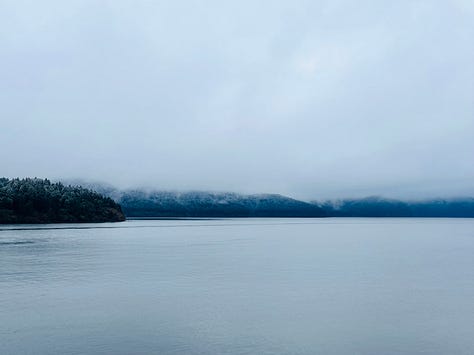
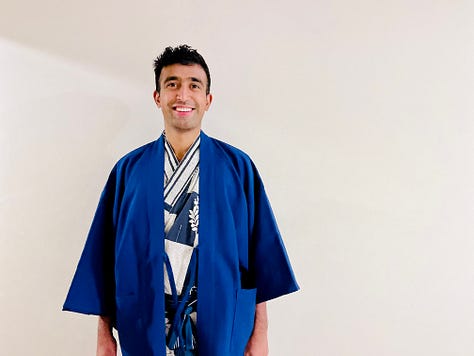

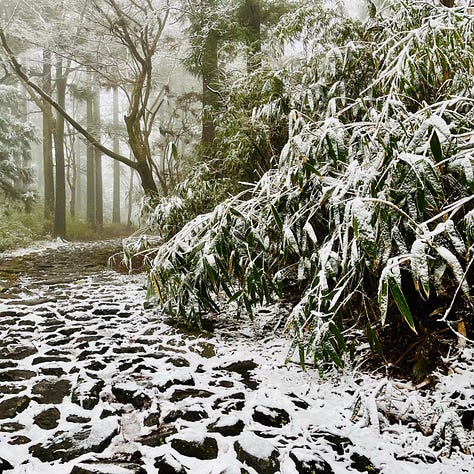
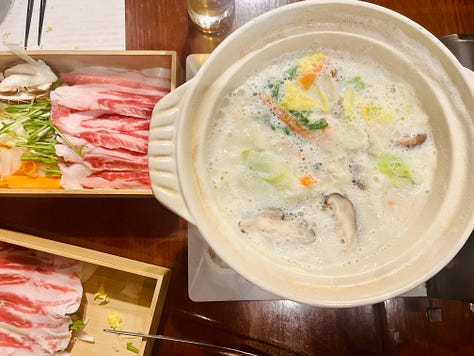
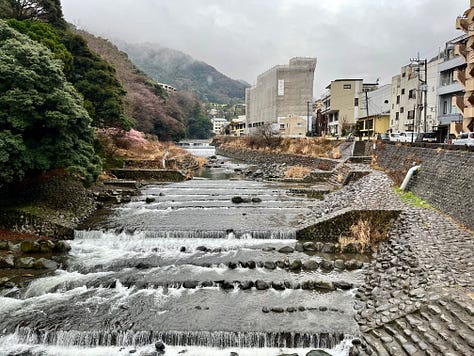
The blue-green waters of Japan
Below are two photos of the private bath in the outdoor balcony of our ryokan room. The water in this bath comes directly from a hot spring. This bath is never drained. The tub overflows as you sink in and refills to the rim from that round basin. A very gentle trickle of hot spring water overflows from the basin and into the bath. Steam rises into the chilled air. The blue-green of the water is indescribably lovely.
The climate here is wet and lush even as it is cold. The geography is mountainous and there are numerous gentle streams that trickle down these mountainsides. In Japan, I often hear the sound of trickling water when we are out in nature, in any kind of garden or park, or at any temple or shrine. I think it is a beloved sound. And like our hot springs bath, these streams and the pools of water that they form are sometimes a deep blue-green, from the moss and algae that grow into the rock, soil, and vegetation.
I’ll leave it here for now. Until later.

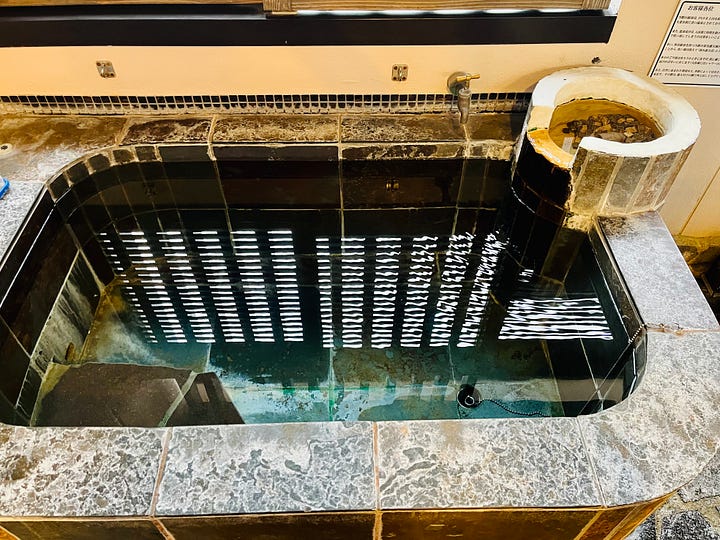



Eek, sounds like there are infinite possibilities available even on one simple restaurant menu! Loved hearing about the Bihari restaurant owner. I'm also convinced Japan is probably heaven on earth :)
Wonderful to learn of your experiences there Tatum. The kanji challenges were funny to hear about. With the "we don't have normal here" comeback. It's hard for some people to make inferences! Yumiko's nephew who was grade school used to think I was like a first-grader because of my limited ability in JApanese, and her parents would tell him that he needs to have patience with me (gamon steru). And yes, highlighting the sound of water (mizu no oto) is a virtue of the Japanese. They don't take for granted the peace of the present moments. You captured it beautifully in your story. Finally, i chuckled at the Bihari story with Raghav mishmashing Japanese and Hindi with the store owner. A rare occasion in life for you two. Thanks for sharing the fun.